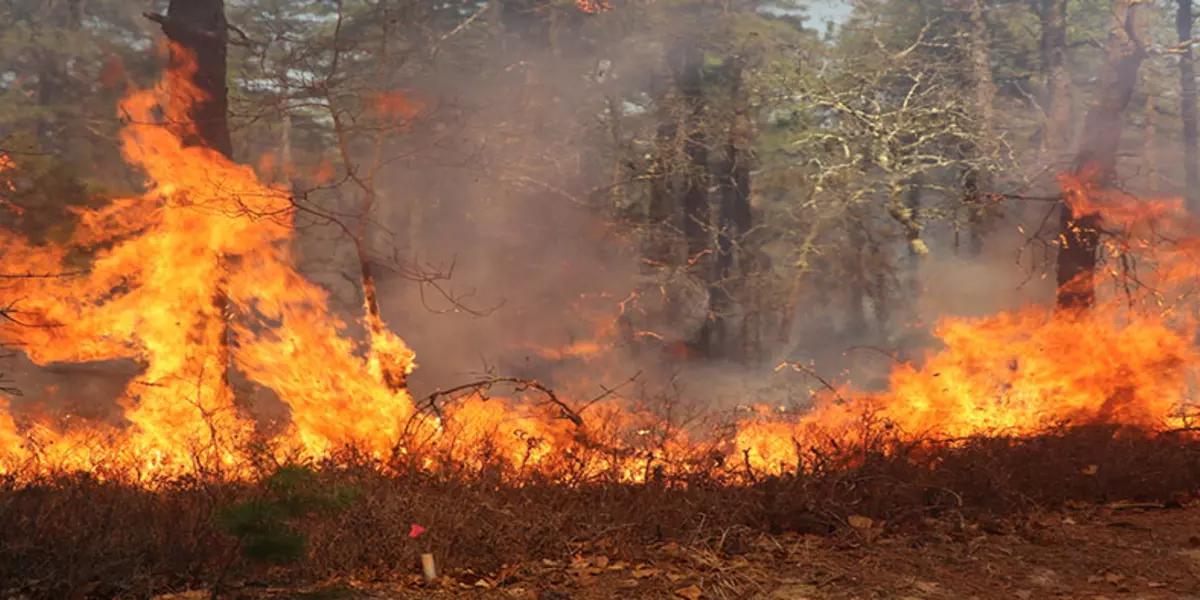
A prescribed forest management burn in New Jersey's Franklin Parker Preserve.
In the Eye of the Fire
“In experimental fire research, some of the most compelling data you can get is the visual data from video and photography,” says Matt Hoehler, a research structural engineer at the National Institute of Standards and Technology (NIST) in Gaithersburg, Maryland. “So we’re always trying to get closer to the fire.”
With a prototype camera system developed by Hoehler and his colleagues at NIST’s National Fire Research Laboratory (NFRL), he has succeeded not just in getting close to a fire, but inside it. So far, the system has captured mesmerizing 360-degree video from a burning room, a mock-up of a museum collection storage room, a kitchen fire and, most recently, a forest fire. The footage allows a viewer to immerse themselves in the scene and shift their gaze in any direction to look at different aspects of the fire.
At the NFRL, scientists and engineers develop ways to measure fire and its effects to help designers, engineers and emergency responders find the best ways to protect people, buildings and other infrastructure.
Fire researchers have long used still photography to record conditions before and after an experiment, but they were limited to two dimensions. In the last few years, high-resolution, spherical cameras with multiple lenses have been getting smaller, better and cheaper, making the NIST effort possible.
The project to capture video from within a fire began in 2015, when Hoehler and his colleagues were using lasers to measure distances to objects within a fire. The lasers were placed near the fire, not in it, but they were close enough that the heat from the fire would damage them.
“We were developing filters to strip off the intense thermal radiation when we realized water could do a really good job without the expense,” says Hoehler.
The heat from a fire travels in three ways. Standing in front of it, you can feel the hot air rush toward you; that’s convection. But you are primarily warmed by the electromagnetic energy the fire emits—that’s radiation, which includes the visible light you see, but is primarily infrared energy. Once the heat from those two paths hits an object, it can move through the object by conduction. Wood doesn’t conduct heat very well, but metal does, for example.
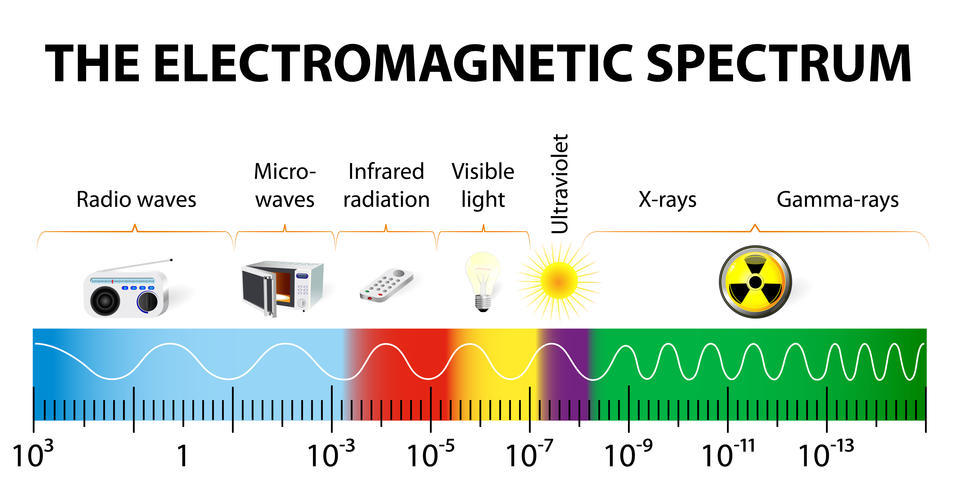
“On a hot summer day, you are feeling about 1 kilowatt per square meter of energy of electromagnetic radiation from the sun. In a large room fire you can easily get 100 to 200 times that flux of energy,” says Hoehler.
“A layer of water just 30 millimeters thick can reduce 100 kilowatts per square meter of incoming energy to less than 1 kilowatt per square meter. In our camera system, the radiant energy is absorbed by the water, the water gets warmer, and we replace it with cold water,” says Hoehler.
The first prototype consisted of a camera in a heat-resistant glass container filled with water—and a cable attached to the camera, just in case. In a video explaining how the team used the early system, there’s a clip showing the water beginning to boil. The next scene bounces around as the camera is pulled away from the fire.
As Hoehler explains in the video, “In case things don’t go as planned, it’s always good to have a backup.”
With each test, the NIST team has improved and refined its camera enclosure system to make it more robust and able to capture better images. Hoehler became a bit obsessed with creating the next prototype during a series of experiments to study how a building material called cross-laminated timber contributes to a fire.
One Saturday, while attending his daughter’s gymnastics practice, he sketched out his plans for the latest version. Unfortunately, there was not enough time to build it before the timber experiment was complete.
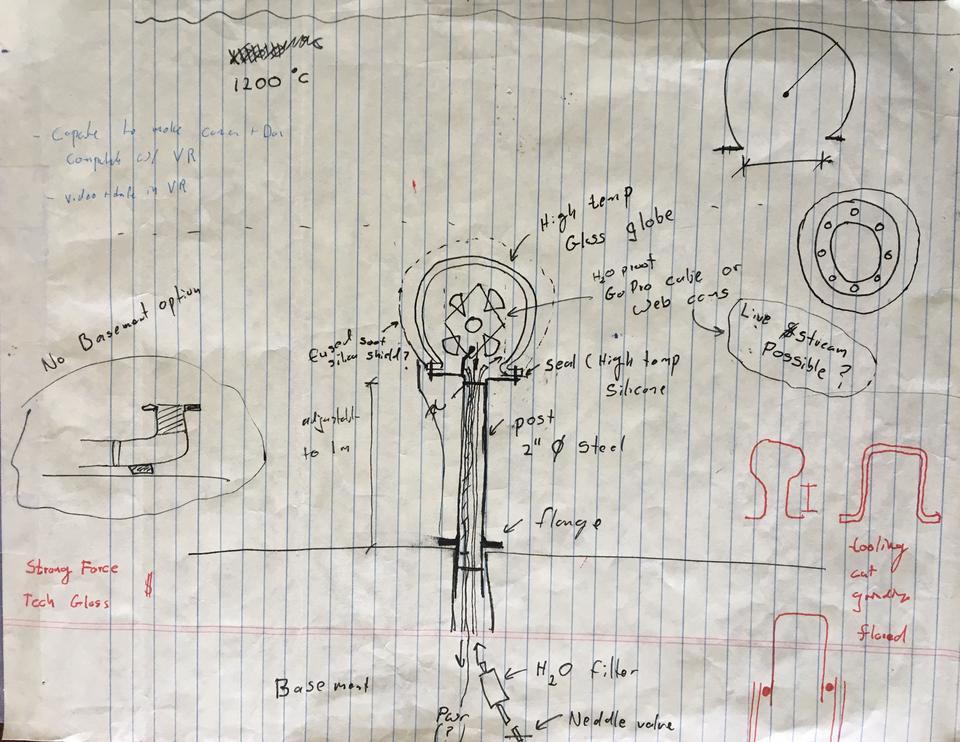
A sketch of NIST engineer Matt Hoehler's vision for the latest prototype of his Burn Observation Bubble (BOB)
Once that project was over, Hoehler applied for funding through an internal NIST program that supports exploratory projects such as prototype building. In July 2018, he completed the first Burn Observation Bubble, or BOB, which consists of a globe of high-temperature glass, filled with water. Water circulates through the globe via pipes. For field deployments, that pipe leads to a buried tank. (In the forest fire video, you can hear the hum of the water pump before the sounds of the rushing fire drown it out.) Various commercially available cameras can be placed inside the globe.
With this new system, Hoehler says, “We can put a 360-degree camera where you couldn’t, or wouldn’t want to, send a person to capture video.”
And after three tests in indoor fires, where Hoehler wanted to put the BOB was inside a forest fire.
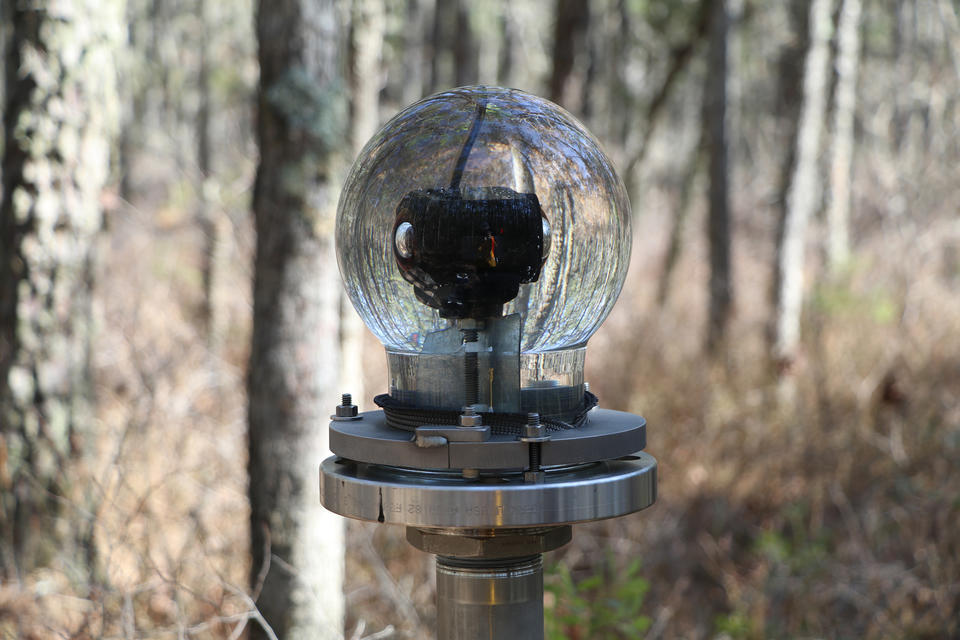
The Burn Observation Bubble (BOB) allows researchers to collect 360-degree videos from within a fire. It uses a globe of temperature-resistant glass and circulating water to protect a camera from a fire's harmful radiation.
The Prescribed Burn
Wildlands—areas that are left in their natural state—can pose fire hazards to the communities that increasingly encroach upon them. This is known as the wildland-urban interface, or WUI. In southern New Jersey, the Franklin Parker Preserve protects a portion of a unique ecosystem called the New Jersey Pine Barrens, an area of heavily forested coastal plain that early settlers learned was not suitable for farming. Far from being barren, the preserve is filled with diverse flora and fauna, including of course, pine trees.
The New Jersey Forest Fire Service, in coordination with the U.S. Forest Service and the New Jersey Conservation Foundation, conducts prescribed forest management burns there as part of a fuel reduction plan. By periodically clearing out some growth, the effort reduces fire risk for nearby communities and promotes a more varied range of plant species, and a healthy forest.
Hoehler learned about upcoming Pine Barren burns from Rory Hadden, who researches fire safety engineering at the University of Edinburgh, in Scotland. Hadden and Mike Gallagher, a fire researcher for the U.S. Forest Service, planned to set up their own equipment during the fires. They study the embers (what fire researchers call “firebrands”) that float up from a fire and help carry it into unburned areas.
The prescribed burns give researchers a unique opportunity to study a fire because they know where and when it will be happening. That doesn’t mean the fire will always move as predicted. Weather conditions are carefully monitored to reduce risks and to make sure the prescribed “dose” of fire does what’s expected.
Hoehler traveled to New Jersey twice before conditions were right. And for at least one of the video shoots, the fire petered out as it arrived at the camera site. But even when they don’t look dramatic, the videos provide important data for researchers.
The recently released video is dramatic. It offers a unique view that lets you virtually stand in front of the oncoming fire, turn to look down its advancing line and watch smoke and embers float through the air while you hear the rush of wind created by the fire’s heat.
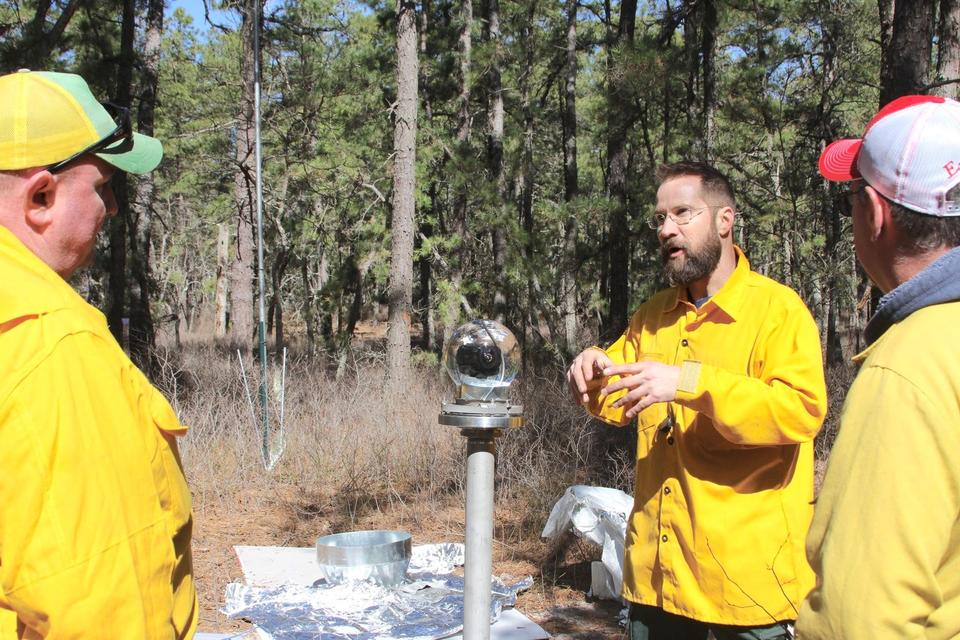
NIST research structural engineer Matt Hoehler (center) explains the Burn Observation Bubble (BOB) to Deputy District Firewarden John Ellicott and District Firewarden Brian Gerber, of the New Jersey Forest Fire Service.
“This type of video greatly expands our ability to observe and measure the extremely harsh fire environment,” says Gallagher. He notes that it could “serve as a valuable tool to improve training to educate researchers, firefighters, land managers and the public about fire.”
Hadden agrees. “The ability to see inside the wildfire is essential to help corroborate our experimental findings. For example, we have previously used video footage to identify where firebrands are generated. Being able to do this in 360 degrees will reduce the number of measurement points needed and allow us to see what happens after the fire passes the measurement point.”
Gallagher says the new system has the potential to reveal phenomena their other sensors might miss.
“For instance, the range of strong air flows created by the fire before, during, and following the flaming front are extremely interesting but not well documented in the literature,” he says. “Now that we’ve tested this camera technology, we could design future experiments to pair sensor and visual measurements about flames, fire spread, spotting and wind with the camera.”
Communicating in 360 Degrees
Hoehler is excited about another aspect of the new system: In addition to offering visual data researchers could not otherwise get, it has the potential to combine the visuals with data from other sensors.
For example, the NIST team has taken the video from a museum storage room fire experiment and added temperature data. Wearing a virtual reality headset, a fire researcher, museum archivist or firefighter can immerse themselves in the fire and focus on the elements most important to them. For example, the researcher might want to know the temperature at the sprinkler heads on the ceiling, while the firefighter might choose to watch how smoke leaves through the doorway. The archivist can gain an appreciation for just how hot shelving—and therefore artifacts—across the room can get before fire even reaches them.
The University of Edinburgh’s Hadden also sees value in the immersive experience the 360-degree view provides. “This technology could be used to demonstrate to stakeholders the differences in wildfire behavior under different conditions, adding a visual layer on to the quantitative data.”
“It can allow a transformation in the way we communicate wildfire research,” he says. “Visualizing a wildfire is something that few researchers and stakeholders have the opportunity to do, and the virtual reality applications of the 360-degree video is a fantastic opportunity to show what a wildfire looks like. This is a significant step to communicate the challenges in understanding wildfires and the risks they present.”
The effort to capture the 360-degree view has inspired another group of NIST researchers, who model fire behavior. They are now offering 360-degree views in their visualizations, which can give viewers insight into how fire will move in a particular space, under various conditions.
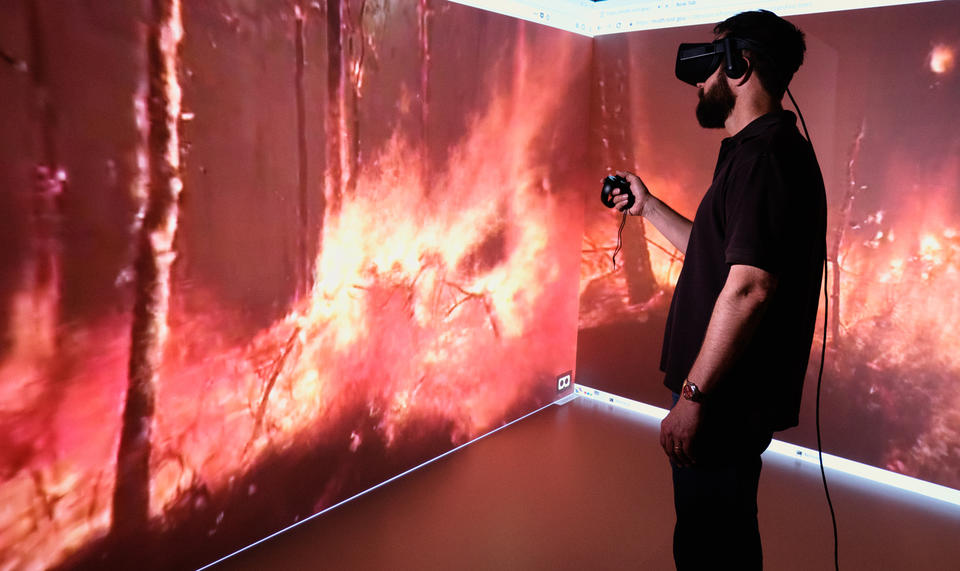
NIST researcher Matt Hoehler uses NIST's 3D visualization laboratory, called the CAVE, to view the 360-degree video taken from within a forest fire by the Bubble Observation Bubble camera system.
“It’s like going from watching a movie, where the director has decided where you would look, to being able to look anywhere you want on the set,” says Glenn Forney, a fire visualization specialist who helps develop NIST’s popular Fire Dynamics Simulator and Smokeview software.
“The advancement of 360-degree video technology, as well as virtual and augmented reality tools, is so rapid these days,” says Hoehler. “It feels like every month we see new ways to interface our work with the research that others are doing. The BOB camera provides a unique and new perspective of fires that will hopefully help to educate people about fire behavior and inspire the development of new tools for fire research.”

